Biomass Sorghum (Sorghum bicolor) Agronomic Response to Melanaphis sorghi (Hemiptera: Aphididae) Infestation and Silicon Application
Simple Summary
Abstract
1. Introduction
2. Materials and Methods
2.1. Melanaphis Sorghi Colony
2.2. Soil Characterization, Preparation, and Fertilization
2.3. Assessment of Agronomic Parameters
2.4. Chemical and Bromatological Composition Analysis
2.5. Statistical Analysis
3. Results
3.1. Interaction Between Silicon and Melanaphis Sorghi Infestation
3.2. Effect of Silicon on Plant Growth and Composition
3.3. Effect of Melanaphis Sorghi Infestation on Plant Growth and Nutrition
4. Discussion
5. Conclusions
Supplementary Materials
Author Contributions
Funding
Data Availability Statement
Acknowledgments
Conflicts of Interest
Abbreviations
| EMBRAPA | Brazilian Agricultural Research Corporation |
| FAPEMIG | Minas Gerais State Research Support Foundation |
| FINEP | Funding Agency for Studies and Projects |
| NIRS | Near-Infrared Spectroscopy |
| PPBE | Postgraduate Program in Bioengineering |
| PPGCA | Postgraduate Program in Agricultural Sciences |
| UFSJ | Federal University of São João del-Rei |
References
- Mammadov, N.; Akbarova, S. Research Areas on Transition to Renewable Energy Sources in Bibliographic Publications. BIO Web Conf. 2025, 151, 02007. [Google Scholar] [CrossRef]
- Feng, Y.; Xu, R. Advancing Global Sustainability: The Role of the Sharing Economy, Environmental Patents, and Energy Efficiency in the Group of Seven’s Path to Sustainable Development. Sustainability 2025, 17, 322. [Google Scholar] [CrossRef]
- Bernardeli, A.; Damasceno, C.M.B.; de Magalhães, J.V.; de Souza, V.F.; de Oliveira Melo, J.; de Oliveira, A.A.; Simeone, M.L.F.; Borém, A.; Schaffert, R.E.; da Costa Parrella, R.A.; et al. Population Genomics and Molecular Breeding of Sorghum. In Population Genomics: Crop Plants; Springer: Cham, Switzerland, 2022; pp. 289–340. [Google Scholar] [CrossRef]
- Bakari, H.; Djomdi; Ruben, Z.F.; Roger, D.D.; Cedric, D.; Guillaume, P.; Pascal, D.; Philippe, M.; Gwendoline, C. Sorghum (Sorghum bicolor L. Moench) and Its Main Parts (By-Products) as Promising Sustainable Sources of Value-Added Ingredients. Waste Biomass Valor. 2023, 14, 1023–1044. [Google Scholar] [CrossRef]
- Castro, F.M.R.; Lombardi, G.M.R.; Nunes, J.A.R.; da Costa Parrella, R.A.; Bruzi, A.T. Accumulation of Biomass and Lignocellulosic Compounds in Photoperiod-Sensitive Biomass Sorghum Genotypes. Biomass Bioenerg. 2022, 158, 106344. [Google Scholar] [CrossRef]
- Adeoye, A.O.; Lawal, O.S.; Quadri, R.O.; Malomo, D.; Aliyu, M.T.; Dang, G.E.; Emojevu, E.O.; Maikato, M.J.; Yahaya, M.G.; Omonije, O.O.; et al. Sustainable Energy via Thermochemical and Biochemical Conversion of Biomass Wastes for Biofuel Production. In Transportation Energy and Dynamics; Springer: Singapore, 2023; pp. 245–306. [Google Scholar] [CrossRef]
- Ameen, M.; Mahmood, A.; Shehzad, A.N.; Zia, M.A.; Javaid, M.M. Sorghum’s Potential Unleashed: A Comprehensive Exploration of Bio-Energy Production Strategies and Innovations. Bioresour. Technol. Rep. 2024, 27, 101906. [Google Scholar] [CrossRef]
- Thudi, M.; Reddy, M.S.; Naik, Y.D.; Cheruku, V.K.R.; Sangireddy, M.K.R.; Cuevas, H.E.; Knoll, J.E.; Louis, J.; Kousik, C.S.; Toews, M.D.; et al. Invasive Sorghum Aphid: A Decade of Research on Deciphering Plant Resistance Mechanisms and Novel Approaches in Breeding for Sorghum Resistance to Aphids. Crop Sci. 2024, 64, 2436–2458. [Google Scholar] [CrossRef]
- Armstrong, J.S.; Mbülwe, L.; Sekula-Ortiz, D.; Villanueva, R.T.; Rooney, W.L. Resistance to Melanaphis sacchari (Hemiptera: Aphididae) in Forage and Grain Sorghums. J. Econ. Entomol. 2017, 110, 259–265. [Google Scholar] [CrossRef] [PubMed][Green Version]
- Armstrong, J.S.; Harris-Shultz, K.R.; Ni, X.Z.; Wang, H.L.; Knoll, J.E.; Anderson, W.F. Utilizing Biodemographic Indices to Identify Perennial Bioenergy Grasses as Sugarcane Aphid (Hemiptera: Aphididae) Host Plants. Trends Entomol. 2019, 15, 1–14. [Google Scholar]
- Armstrong, J.S.; Rooney, W.L.; Peterson, G.C.; Villenueva, R.T.; Brewer, M.J.; Sekula-Ortiz, D. Sugarcane Aphid (Hemiptera: Aphididae): Host Range and Sorghum Resistance Including Cross-Resistance from Greenbug Sources. J. Econ. Entomol. 2015, 108, 576–582. [Google Scholar] [CrossRef]
- Paudyal, S.; Armstrong, J.S.; Harris-Shultz, K.; Wang, H.; Giles, K.; Rott, P.; Payton, M. Evidence of Host Plant Specialization Among the US Sugarcane Aphid (Hemiptera: Aphididae) Genotypes. Trends Entomol. 2019, 15, 47–58. [Google Scholar]
- Avellar, G.S.; Marriel, I.E.; Menezes, C.B.; Santos, D.G.; Santos, N.M.; Mendes, S.M. Pulgão Melanaphis sorghi (Theobald, 1904) (Hemiptera: Aphididae) na cultura do sorgo: Análise do cenário brasileiro. Entomol. Commun. 2023, 5, ec05042. [Google Scholar] [CrossRef]
- Uyi, O.; Toews, M.D. Melanaphis sorghi: A Review and Synthesis of Its Control Options 10 Years Post Detection of a New Invasive Haplotype in the United States of America. CABI Rev. 2024, 19, 1–15. [Google Scholar] [CrossRef]
- Vasquez, A.; Belsky, J.; Khanal, N.; Puri, H.; Balakrishnan, D.; Joshi, N.K.; Louis, J.; Studebaker, G.; Kariyat, R. Melanaphis sacchari/sorghi Complex: Current Status, Challenges and Integrated Strategies for Managing the Invasive Sap-Feeding Insect Pest of Sorghum. Pest Manag. Sci. 2024, 80, 2427–2441. [Google Scholar] [CrossRef] [PubMed]
- Verma, K.K.; Song, X.P.; Tian, D.D.; Guo, D.J.; Chen, Z.L.; Zhong, C.S.; Nikpay, A.; Singh, M.; Rajput, V.D.; Singh, R.K.; et al. Influence of Silicon on Biocontrol Strategies to Manage Biotic Stress for Crop Protection, Performance, and Improvement. Plants 2021, 10, 2163. [Google Scholar] [CrossRef]
- Thakur, A.; Singh, A.; Tandon, A.; Sharma, V. Insights into the Molecular Mechanisms of Uptake, Phytohormone Interactions and Stress Alleviation by Silicon: A Beneficial but Non-Essential Nutrient for Plants. Plant Growth Regul. 2023, 101, 1–13. [Google Scholar] [CrossRef]
- Mandlik, R.; Thakral, V.; Raturi, G.; Shinde, S.; Nikolić, M.; Tripathi, D.K.; Sonah, H.; Deshmukh, R. Significance of Silicon Uptake, Transport, and Deposition in Plants. J. Exp. Bot. 2020, 71, 6703–6718. [Google Scholar] [CrossRef]
- Carvalho, J.S.; Frazão, J.J.; de Mello Prado, R.; de Souza Júnior, J.P.; Costa, M.G. Silicon Modifies C:N:P Stoichiometry and Improves the Physiological Efficiency and Dry Matter Mass Production of Sorghum Grown Under Nutritional Sufficiency. Sci. Rep. 2022, 12, 16082. [Google Scholar] [CrossRef]
- Carvalho, S.P.; Moraes, J.C.; Carvalho, J.G. Efeito do Silício na Resistência do Sorgo (Sorghum bicolor) ao Pulgão-Verde Schizaphis graminum (Rond.) (Homoptera: Aphididae). An. Soc. Entomol. Bras. 1999, 28, 505–510. [Google Scholar] [CrossRef]
- Santos, D.G.D.; Dias, L.L.C.; Avellar, G.S.D.; Simeone, M.L.F.; Oliveira, I.R.D.; Menezes, C.B.D.; Santos, N.M.D.; Mendes, S.M. Effect of Silicon on Melanaphis sorghi (Theobald, 1904) (Hemiptera: Aphididae) Infesting Grain Sorghum (Sorghum bicolor). Int. J. Pest. Manag. 2025, 1–10. [Google Scholar] [CrossRef]
- Biru, F.N.; Nayak, J.J.; Waterman, J.M.; Cazzonelli, C.I.; Elbaum, R.; Johnson, S.N. Elevated Atmospheric CO2 and Silicon Antagonistically Regulate Anti-Herbivore Phytohormone and Defence Gene Expression Levels in Wheat. Environ. Exp. Bot. 2024, 227, 105950. [Google Scholar] [CrossRef]
- Qi, X.; Xue, X.; Wang, Z.; Li, S.; Zhang, Z.; Han, Y.; Wang, Y.; Jiang, Y. Silicon Application Enhances Wheat Defence Against Sitobion avenae F. by Regulating Plant Physiological-Biochemical Responses. Basic Appl. Ecol. 2024, 74, 13–23. [Google Scholar] [CrossRef]
- Wang, X.; Li, W.; Yan, J.; Wang, Y.; Zhang, X.; Tan, X.; Chen, J. Developmental, Reproduction, and Feeding Preferences of the Sitobion avenae Mediated by Soil Silicon Application. Plants 2023, 12, 989. [Google Scholar] [CrossRef] [PubMed]
- Oliveira, R.S.; Peñaflor, M.F.G.; Gonçalves, F.G.; Sampaio, M.V.; Korndörfer, A.P.; Silva, W.D.; Bento, J.M.S. Silicon-Induced Changes in Plant Volatiles Reduce Attractiveness of Wheat to the Bird Cherry-Oat Aphid Rhopalosiphum padi and Attract the Parasitoid Lysiphlebus testaceipes. PLoS ONE 2020, 15, e0231005. [Google Scholar] [CrossRef] [PubMed]
- Merck KGaA. Specification: Silicic Acid Precipitated Extra Pure Light; MilliporeSigma: Darmstadt, Germany, 2017. [Google Scholar]
- Fernandes, F.O.; Souza, C.D.S.F.; de Avellar, G.S.; Nascimento, P.T.; Damasceno, N.C.R.; dos Santos, N.M.; Lima, P.F.; dos Santos, M.V.C.; Simeone, M.L.F.; da Costa Parrella, R.A.; et al. (Embrapa Milho e Sorgo, Brasília, DF, Brazil) Manejo do Pulgão da Cana-de-Açúcar (Melanaphis sacchari/sorghi) na Cultura do Sorgo. Comun. Técnico 2021, 249, 1–24. [Google Scholar]
- Van Den Berg, J. Status of Resistance of Sorghum Hybrids to the Aphid, Melanaphis sacchari (Zehntner) (Homoptera: Aphididae). S. Afr. J. Plant Soil 2002, 19, 151–155. [Google Scholar] [CrossRef]
- Guimarães, C.C.; Simeone, M.L.F.; Parrella, R.A.; Sena, M.M. Use of NIRS to Predict Composition and Bioethanol Yield from Cell Wall Structural Components of Sweet Sorghum Biomass. Microchem. J. 2014, 117, 194–201. [Google Scholar] [CrossRef]
- Nogueira, A.R.d.A.; Souza, G.B. Manual de Laboratório: Solo, Água, Nutrição Vegetal, Nutrição Animal e Alimentos; Embrapa Pecuária Sudeste: São Carlos, Brazil, 2005; 334p. [Google Scholar]
- Ferreira, D.F. SISVAR: A Computer Analysis System to Fixed Effects Split Plot Type Designs. Braz. J. Biometrics 2019, 37, 529–535. [Google Scholar] [CrossRef]
- Şahin, M.; Aybek, E. Jamovi: An Easy to Use Statistical Software for the Social Scientists. Int. J. Assess. Tools Educ. 2019, 6, 670–692. [Google Scholar] [CrossRef]
- Minitab LLC. Minitab, Version 21; Minitab LLC: State College, PA, USA, 2021.
- Harizanova, A.S. Silicon Application Unveiled: A Review of Insights into Plant Defense Mechanisms Under Biotic Challenges. Agrar. Nauk. 2024, 16, 41. [Google Scholar] [CrossRef]
- Pereira, S.; Monteiro, A.; Moutinho-Pereira, J.; Dinis, L.T. Silicon, an Emergent Strategy to Lighten the Effects of (A)biotic Stresses on Crops: A Review. J. Agron. Crop Sci. 2024, 210, e12762. [Google Scholar] [CrossRef]
- Djikanović, D.; Jovanović, J.; Kalauzi, A.; Maksimović, J.D.; Radotić, K. Effects of Silicon Concentration and Synthesis Duration on Lignin Structure: A Spectroscopic and Microscopic Study. Biopolymers 2025, 116, e23640. [Google Scholar] [CrossRef] [PubMed]
- Hajiboland, R.; Bahrami-Rad, S.; Poschenrieder, C. Silicon Modifies Both a Local Response and a Systemic Response to Mechanical Stress in Tobacco Leaves. Biol. Plant. 2017, 61, 187–191. [Google Scholar] [CrossRef]
- Vega, I.; Rumpel, C.; Ruíz, A.; Mora, M.D.L.L.; Calderini, D.F.; Cartes, P. Silicon Modulates the Production and Composition of Phenols in Barley Under Aluminum Stress. Agronomy 2020, 10, 1138. [Google Scholar] [CrossRef]
- Zhang, Z.; Rao, Y.; Ye, M.; Zou, D.; Liu, R.; Liu, Y. Reduction of Inhibitory Effect of Lignin via Degradation and Improvement of Anaerobic Digestion Performance of Maize Straw by Oxidative Pretreatment with Fe2+-Activated Persulfate. Renew. Energy 2024, 231, 120795. [Google Scholar] [CrossRef]
- Baez, L.A.; Tichá, T.; Hamann, T. Cell Wall Integrity Regulation Across Plant Species. Plant Mol. Biol. 2022, 109, 483–504. [Google Scholar] [CrossRef]
- Xue, Y.; Li, H.; Kang, X. Molecular Unraveling of Polysaccharide Digestion in Wood-Feeding Termites: A Solid-State NMR Perspective. Carbohydr. Polym. 2024, 331, 121843. [Google Scholar] [CrossRef]
- Jang, S.K.; Jeong, H.; Choi, I.G. The Effect of Cellulose Crystalline Structure Modification on Glucose Production from Chemical-Composition-Controlled Biomass. Sustainability 2023, 15, 5869. [Google Scholar] [CrossRef]
- Rao, J.; Lv, Z.; Chen, G.; Peng, F. Hemicellulose: Structure, Chemical Modification, and Application. Prog. Polym. Sci. 2023, 140, 101675. [Google Scholar] [CrossRef]
- Jincy, E.M.; Femina, K.S. Heteropolymer in Biomass: Hemicellulose Extraction and Modifications. In Handbook of Biomass; Springer: Singapore, 2023; pp. 1–32. [Google Scholar] [CrossRef]
- Rodrigues, P.D.O.; Corrêa, A.G.; Baffi, M.A.; Pasquini, D. Potential Applications of Hemicellulose. In Handbook of Biomass; Springer: Singapore, 2024; pp. 697–727. [Google Scholar] [CrossRef]
- Nechita, P.; Roman, M.; Năstac, S.M. Green Approaches on Modification of Xylan Hemicellulose to Enhance the Functional Properties for Food Packaging Materials—A Review. Polymers 2023, 15, 2088. [Google Scholar] [CrossRef]
- Zexer, N.; Kumar, S.; Elbaum, R. Silica Deposition in Plants: Scaffolding the Mineralization. Ann. Bot. 2023, 131, 897–908. [Google Scholar] [CrossRef]
- Singh, P.; Kumar, V.; Sharma, A. Interaction of Silicon with Cell Wall Components in Plants: A Review. J. Appl. Nat. Sci. 2023, 15, 480–497. [Google Scholar] [CrossRef]
- Coutinho, W.B.G.; da Silva, F.C.; Barrigossi, J.A.F.; de Sousa Almeida, A.C.; Gonçalves de Jesus, F. Silicon Applications in Rice Plants Alter the Stylet Probing Behaviors of Glyphepomis spinosa (Hemiptera: Pentatomidae). J. Insect Sci. 2024, 24, 23. [Google Scholar] [CrossRef] [PubMed]
- Tenguri, P.; Chander, S.; Ellur, R.K.; Patil, E.; Sundaran, A.P.; Yele, Y.; Thube, S.H.; Naik, V.C.; Nagaraju, M.T. Effect of Silicon Application on Rice Plant Defence Against Brown Planthopper Feeding Under Climate Change Conditions. Anim. Biol. 2024, 74, 163–179. [Google Scholar] [CrossRef]
- Kumar, P.T. A Comprehensive Review of Nano-Sized Silica’s Effects on Plant Growth, Molecular Responses, and Biochemical Changes. J. Adv. Biol. Biotechnol. 2024, 27, 421–433. [Google Scholar] [CrossRef]
- Johnson, S.N.; Waterman, J.M.; Hartley, S.E.; Cooke, J.; Ryalls, J.M.; Lagisz, M.; Nakagawa, S. Plant Silicon Defences Suppress Herbivore Performance, but Mode of Feeding Is Key. Ecol. Lett. 2024, 27, e14519. [Google Scholar] [CrossRef]
- Putra, R.; Bünker, M.; Müller, C. Role of Silicon in Legume-Insect Interactions: Insights from a Plant Experiencing Different Levels of Herbivory. Funct. Ecol. 2024, 38, 2693–2708. [Google Scholar] [CrossRef]
- Jiang, Y.; Qi, X.X.; Wang, Z.H.; Liu, X.D.; Han, Y.L.; Li, H.; Wang, Y. Effect of Different Forms of Silicon Application on Wheat Aphid Resistance. Agric. Res. 2023, 12, 179–188. [Google Scholar] [CrossRef]
- Rahman, A.; Hussain, F.; Majeed, S.; Nazeer, M.U.; Sharif, R.M.S.; Asif, M.; Sattar, W. Silicon Applications on Yield Attributes of Wheat (Triticum aestivum L.) and Biology of Wheat-Aphid (Schizaphis Graminum). Silicon 2024, 16, 3165–3172. [Google Scholar] [CrossRef]
- Deka, M.K.; Kalita, P. Impact of Foliar Application of Silicic Acid on Aphid Population Growth, Gas Exchange Parameters and Yield of Rapeseed. Phytoparasitica 2024, 52, 65. [Google Scholar] [CrossRef]
- Ullah, M.S.; Mahmood, A.; Alawadi, H.F.N.; Seleiman, M.F.; Khan, B.A.; Javaid, M.M.; Wasonga, D.O. Silicon-Mediated Modulation of Maize Growth, Metabolic Responses, and Antioxidant Mechanisms under Saline Conditions. BMC Plant Biol. 2025, 25, 3. [Google Scholar] [CrossRef]
- Huang, L.; Tan, Z.; Lei, K.; Wang, L.; Shen, W.; Teng, W. Effect of Silicon Addition on the Growth and Photosynthesis of Castanopsis Hystrix in Manganese Stress. Not. Bot. Horti. Agrobot. Cluj Napoca 2024, 52, 13930. [Google Scholar] [CrossRef]
- Deng, Y.; Yang, M.; Li, T.; Yuan, L.; Zhang, A.; Jiang, D.; Yan, S. Silicon Supplementation Improves Biomass and Direct Defense of Ryegrass: A Multi-Omics Study. Ind. Crops Prod. 2023, 204, 117357. [Google Scholar] [CrossRef]
- Lin, Y.; Lin, X.; Ding, C.; Xia, M.; Xue, R.; Sun, Z.; Chen, D.; Zhu-Salzman, K.; Zeng, R.; Song, Y. Priming of Rice Defense Against a Sap-Sucking Insect Pest Brown Planthopper by Silicon. J. Pest Sci. 2022, 95, 1371–1385. [Google Scholar] [CrossRef]
- Rincón-López, B.; Naveda, A.F.; Lara, U.A.; Hernández, M.E.T.; Tafolla-Arellano, J.C. Sorghum and Aphid (Melanaphis sacchari) Interaction: Plant Physiology, Breeding, and Molecular Overview. In Biocontrol Systems and Plant Physiology in Modern Agriculture; Apple Academic Press: Palm Bay, FL, USA, 2022; pp. 237–256. [Google Scholar]
- Du, J.L.; Wu, D.G.; Li, J.Q.; Zhan, Q.W.; Huang, S.C.; Huang, B.H.; Wang, X. Effects of Aphid Disoperation on Photosynthetic Performance and Agronomic Traits of Different Sorghum Varieties. Pak. J. Bot. 2021, 53, 2275–2285. [Google Scholar] [CrossRef]
- Pavlovic, J.; Kostic, L.; Bosnic, P.; Kirkby, E.A.; Nikolic, M. Interactions of Silicon with Essential and Beneficial Elements in Plants. Front. Plant Sci. 2021, 12, 697592. [Google Scholar] [CrossRef]
- Costa, M.G.; Prado, R.d.M.; Sarah, M.M.S.; Palaretti, L.F.; Piccolo, M.d.C.; Souza Júnior, J.P. New Approaches to the Effects of Si on Sugarcane Ratoon Under Irrigation in Quartzipsamments, Eutrophic Red Oxisol, and Dystrophic Red Oxisol. BMC Plant Biol. 2023, 23, 51. [Google Scholar] [CrossRef]
- Costa, M.G.; Prado, R.D.M.; Santos Sarah, M.M.; Souza Júnior, J.P.; de Souza, A.E.S. Silicon, by Promoting a Homeostatic Balance of C:N:P and Nutrient Use Efficiency, Attenuates K Deficiency, Favoring Sustainable Bean Cultivation. BMC Plant Biol. 2023, 23, 213. [Google Scholar] [CrossRef]
- Costa, M.G.; Mello Prado, R.; Palaretti, L.F.; de Souza Júnior, J.P. The Effect of Abiotic Stresses on Plant C:N:P Homeostasis and Their Mitigation by Silicon. Crop J. 2024, 12, 340–353. [Google Scholar] [CrossRef]
- Barão, L.; Teixeira, R.F. Interaction of Silicon-Phosphorus: The Unexplored Connection in the Soil Ecosystem. Preprints 2024, 2024100945. [Google Scholar] [CrossRef]
- Kostic, I.; Nikolic, N.; Milanovic, S.; Milenkovic, I.; Pavlovic, J.; Paravinja, A.; Nikolic, M. Silicon Modifies Leaf Nutriome and Improves Growth of Oak Seedlings Exposed to Phosphorus Deficiency and Phytophthora plurivora Infection. Front. Plant Sci. 2023, 14, 1265782. [Google Scholar] [CrossRef]
- Coquerel, R.; Arkoun, M.; Trouverie, J.; Bernay, B.; Laîné, P.; Etienne, P. Ionomic and Proteomic Changes Highlight the Effect of Silicon Supply on the Nodules Functioning of Trifolium incarnatum L. Front. Plant Sci. 2024, 15, 1462149. [Google Scholar] [CrossRef] [PubMed]
- Choudhary, S.; Zehra, A.; Wani, K.I.; Naeem, M.; Hakeem, K.R.; Aftab, T. The Role of Micronutrients in Growth and Development: Transport and Signalling Pathways from Crosstalk Perspective. In Plant Micronutrients: Deficiency and Toxicity Management; Springer: Cham, Switzerland, 2020; pp. 73–81. [Google Scholar] [CrossRef]
- Nietupski, M.; Ludwiczak, E.; Olszewski, J.; Gabryś, B.; Kordan, B. Effect of Aphid Foraging on the Intensity of Photosynthesis and Transpiration of Selected Crop Plants in Its Early Stages of Growing. Agronomy 2022, 12, 2370. [Google Scholar] [CrossRef]
- Ramovha, D. Increased Cell Wall Activity on Tugela Dn1 Wheat Cultivar Infested with Russian Wheat Aphid Biotype 2; University of the Free State: Bloemfontein, South Africa, 2021. [Google Scholar] [CrossRef]
- Wang, Y.; Di, B.; Sun, Z.; Sonali; Donovan-Mak, M.; Chen, Z.H.; Wang, M.Q. Multi-Omics and Physiological Analysis Reveal Crosstalk Between Aphid Resistance and Nitrogen Fertilization in Wheat. Plant Cell Environ. 2024, 47, 2024–2039. [Google Scholar] [CrossRef]
- Srihari, P.; Mehera, B.; Swaroop, B.T.; Kumar, P. Effect of Iron and Silicon on Growth and Yield of Sorghum (Sorghum bicolor L.). Int. J. Environ. Clim. Change 2023, 13, 630–636. [Google Scholar] [CrossRef]
- Thorne, S.J.; Hartley, S.E.; Maathuis, F.J. Is Silicon a Panacea for Alleviating Drought and Salt Stress in Crops? Front. Plant Sci. 2020, 11, 1221. [Google Scholar] [CrossRef] [PubMed]
- Thorne, S.J.; Stirnberg, P.M.; Hartley, S.E.; Maathuis, F.J. The Ability of Silicon Fertilisation to Alleviate Salinity Stress in Rice Is Critically Dependent on Cultivar. Rice 2022, 15, 8. [Google Scholar] [CrossRef]
- Toledo-Hernández, E.; Peña-Chora, G.; Mancilla-Dorantes, I.; Torres-Rojas, F.I.; Romero-Ramírez, Y.; Palemón-Alberto, F.; Ortega-Acosta, S.Á.; Delgado-Núñez, E.J.; Salinas-Sánchez, D.O.; Tagle-Emigdio, L.J.; et al. A Review of Biological Control One Decade After the Sorghum Aphid (Melanaphis sorghi) Outbreak. Plants 2024, 13, 2873. [Google Scholar] [CrossRef]
- Domingues, R.F.; Barbosa, M.S.; Sampaio, M.V. Silicon amendment to the crop increases the potential of Aphidius platensis to control the invasive pest aphid Melanaphis sorghi. Pest Manag Sci. 2025; ahead of print. [Google Scholar] [CrossRef]

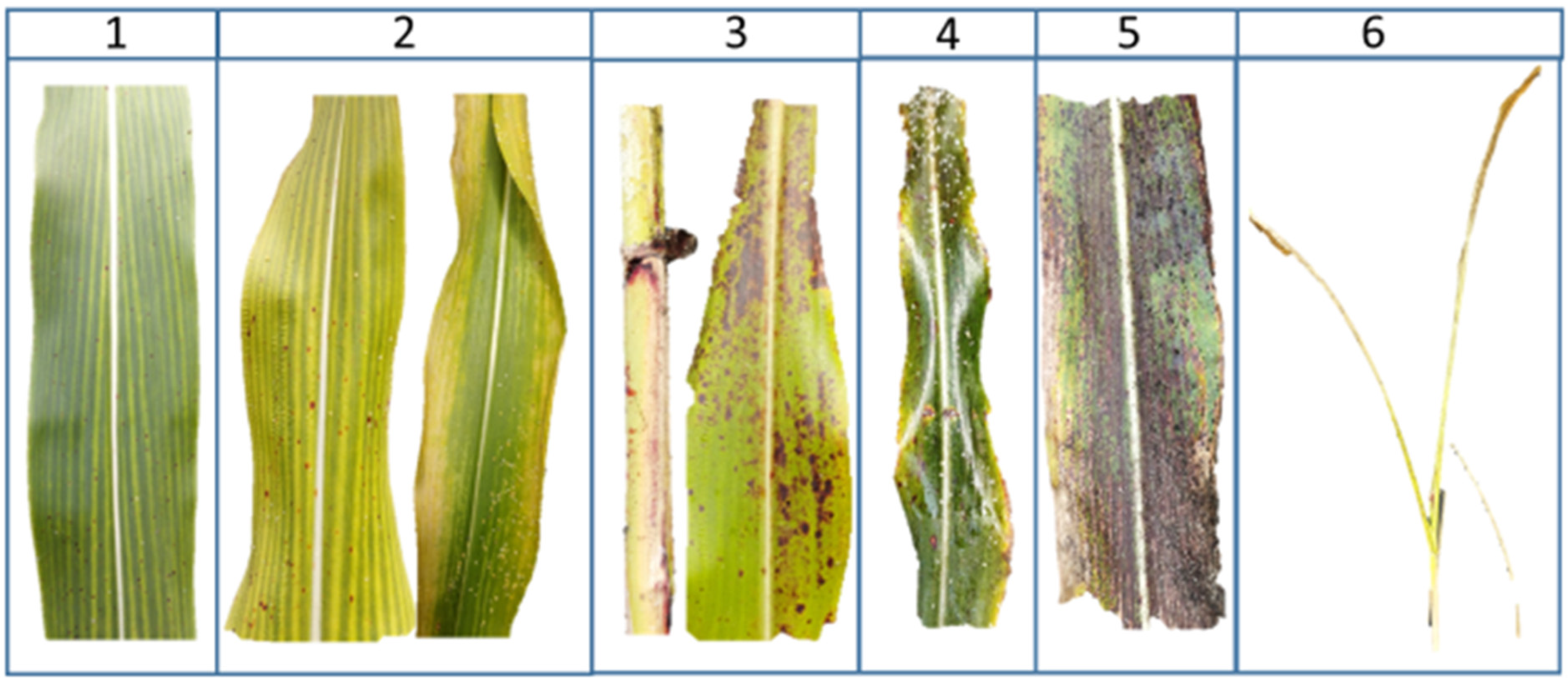


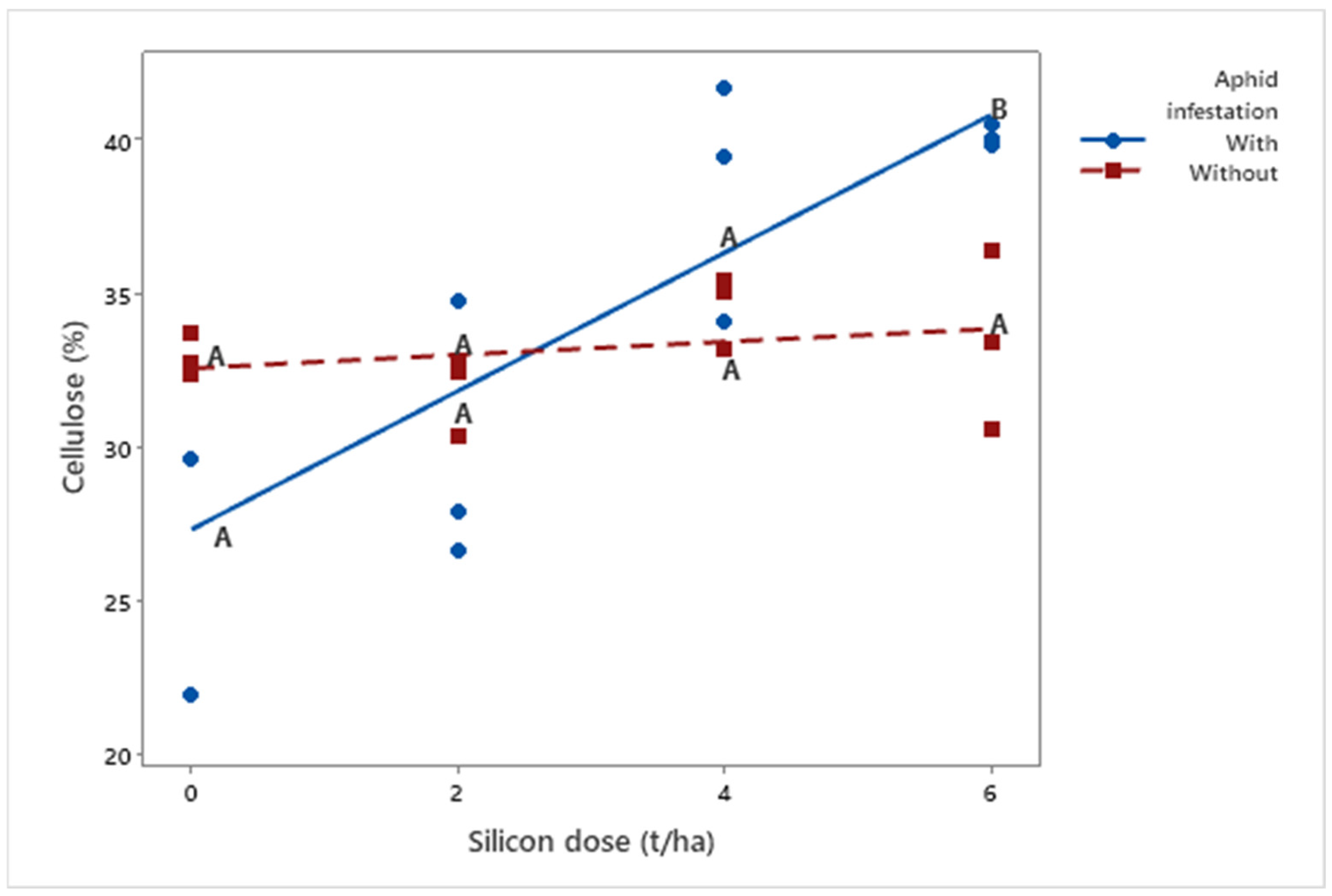
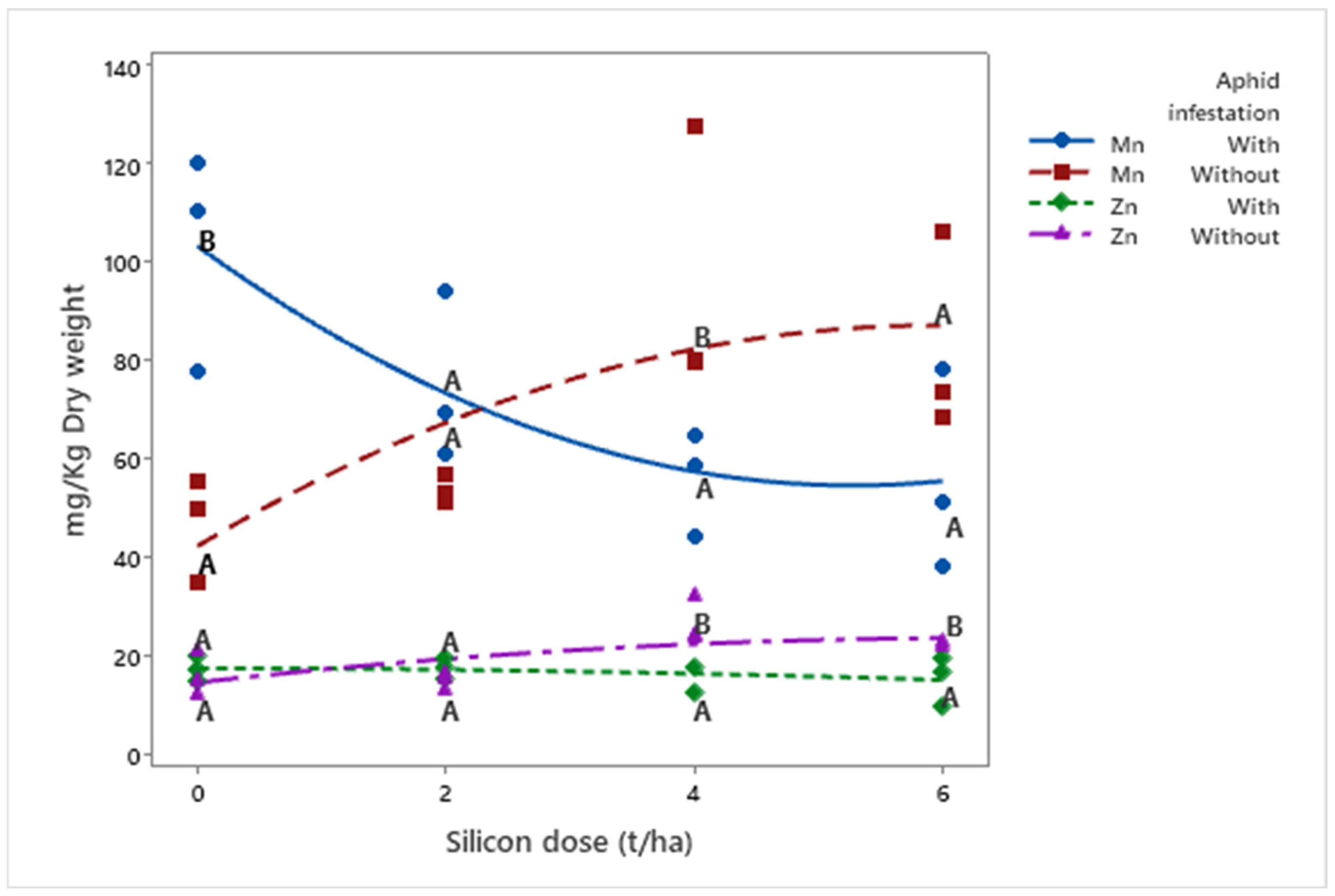
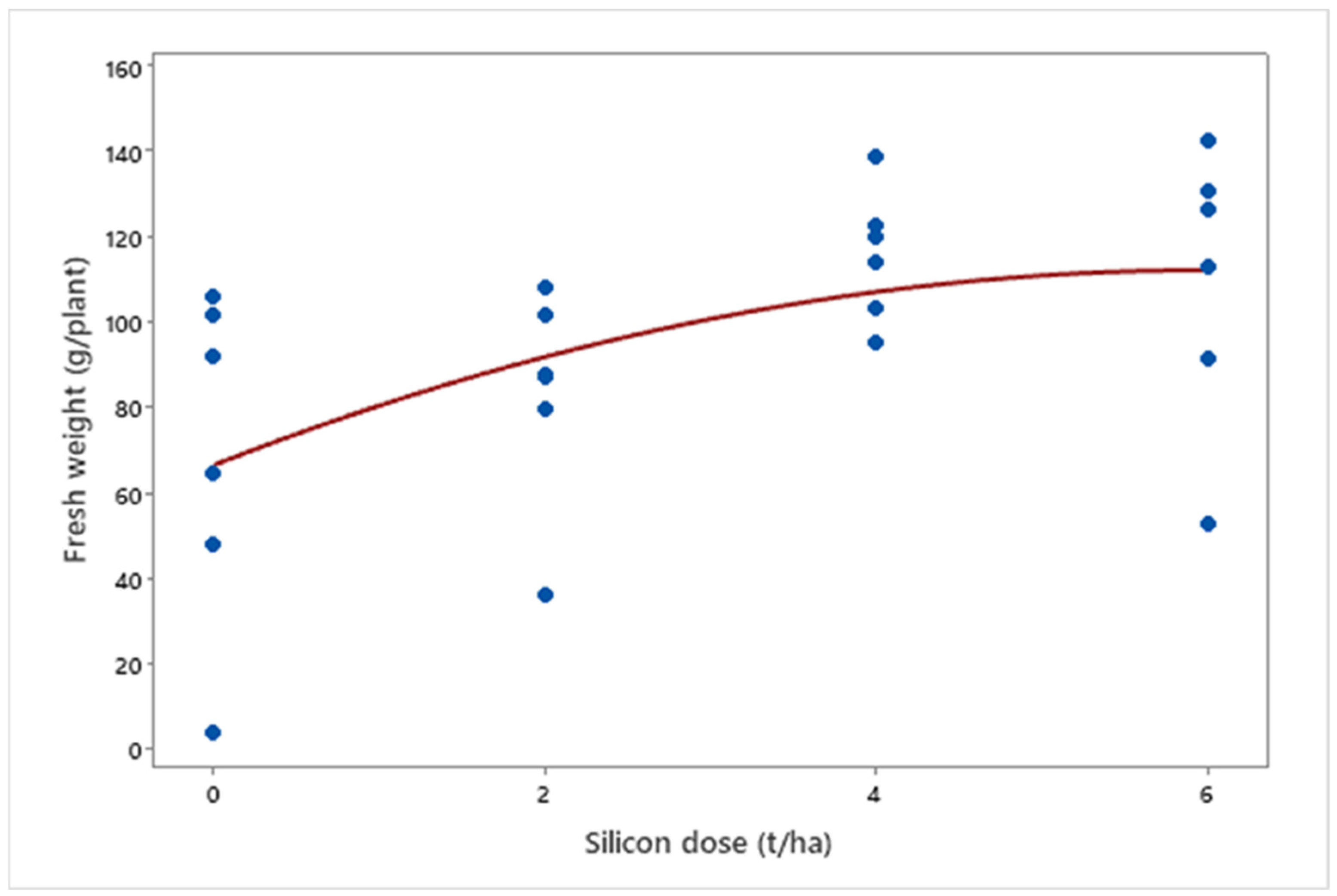
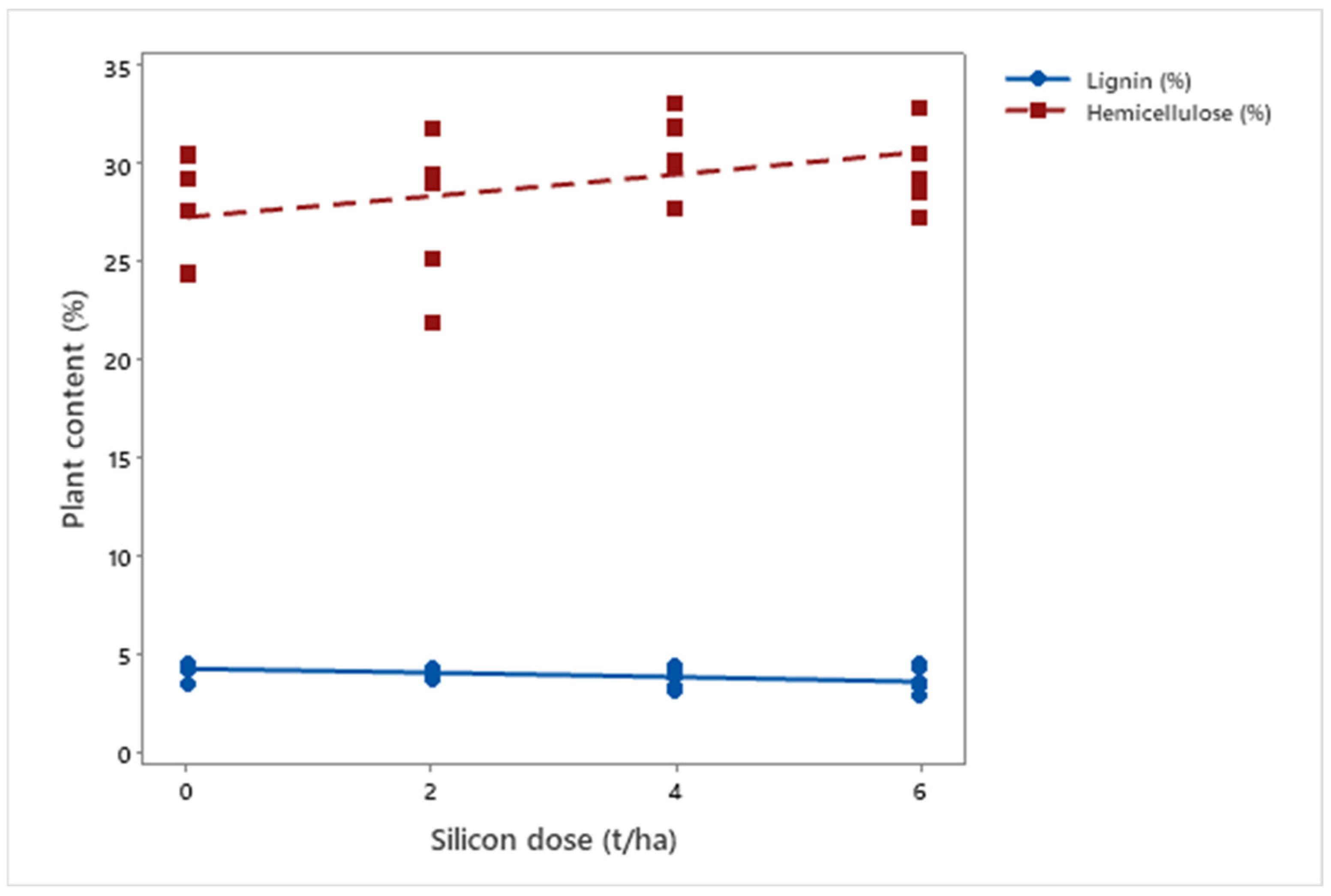

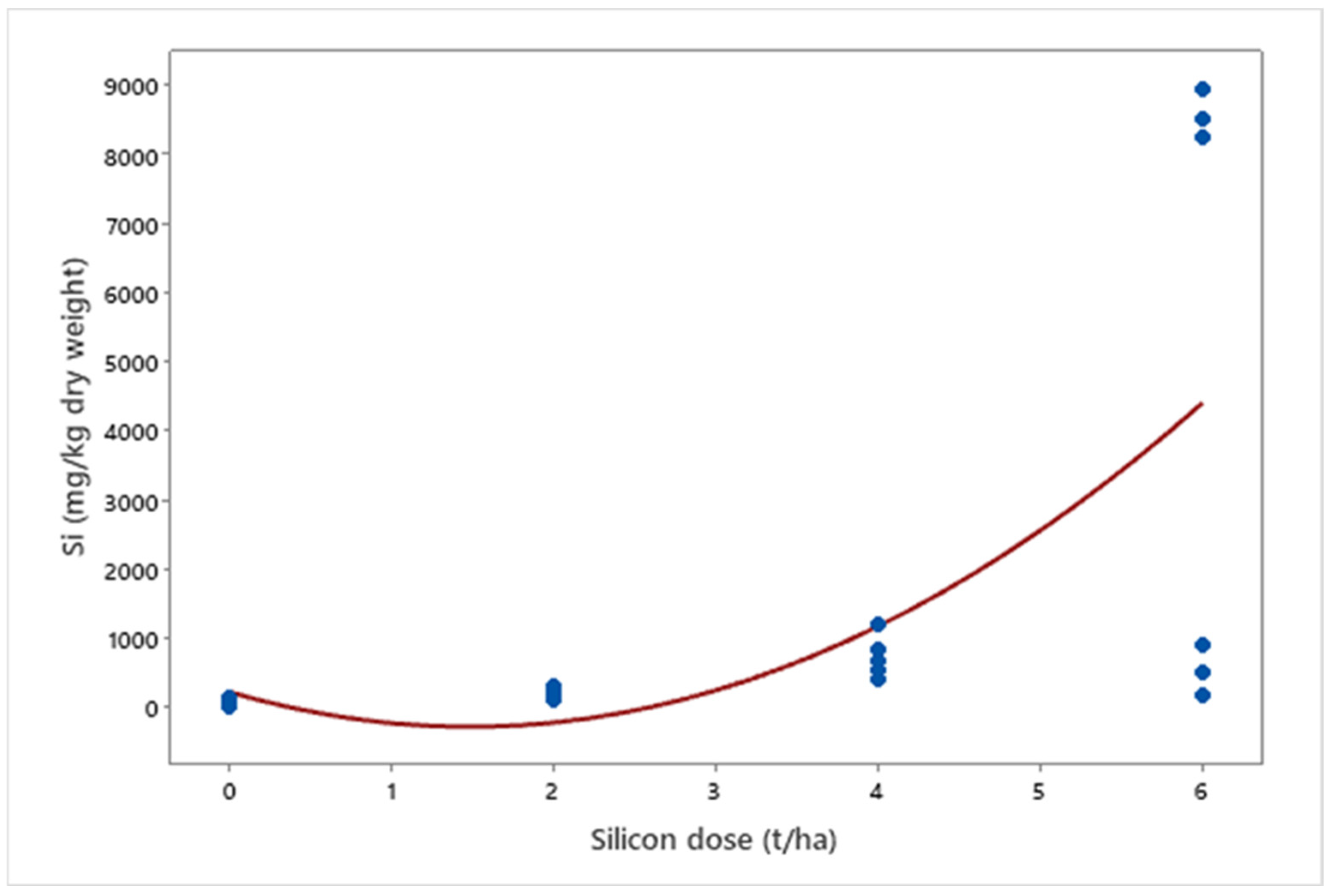
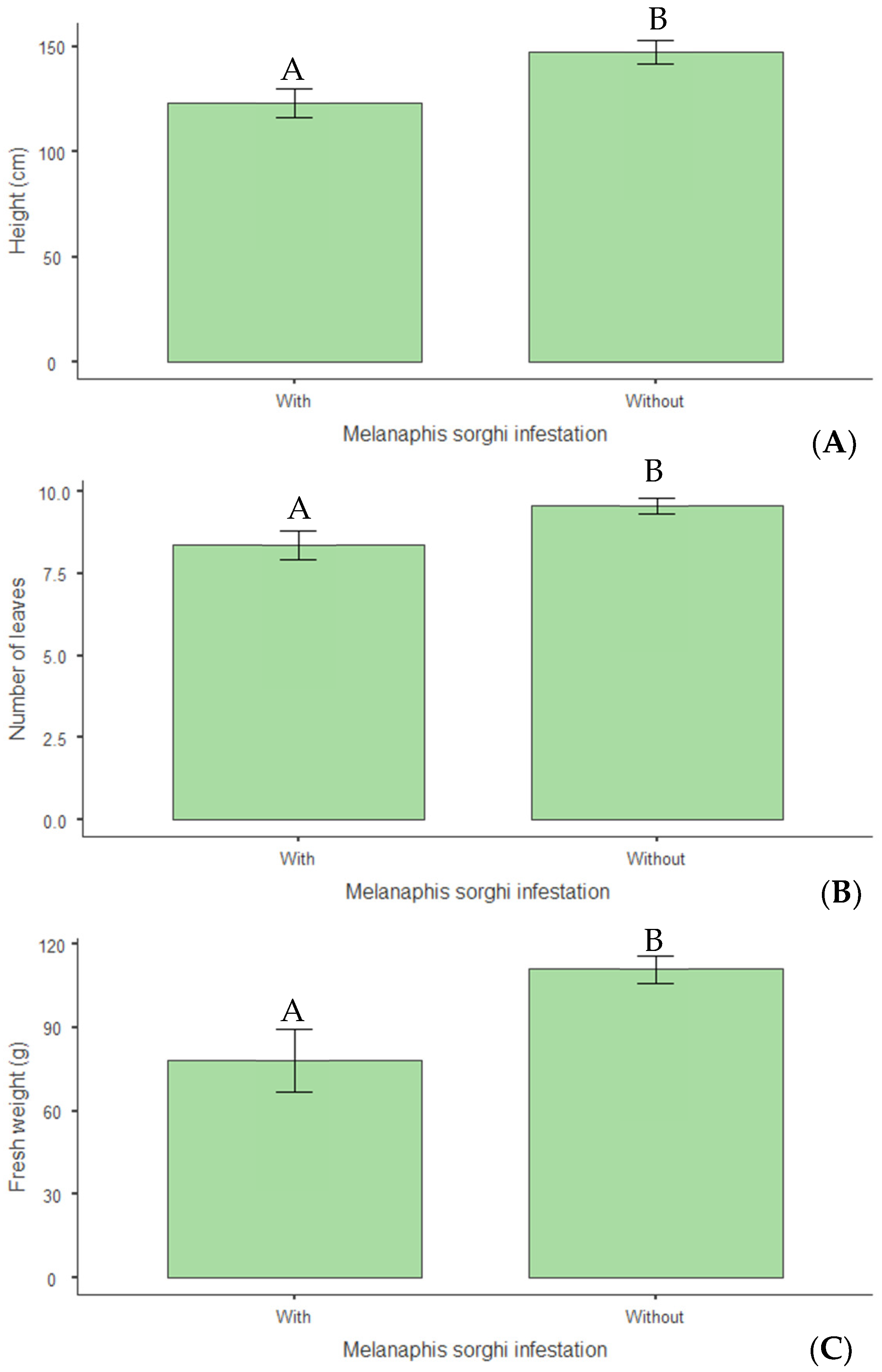
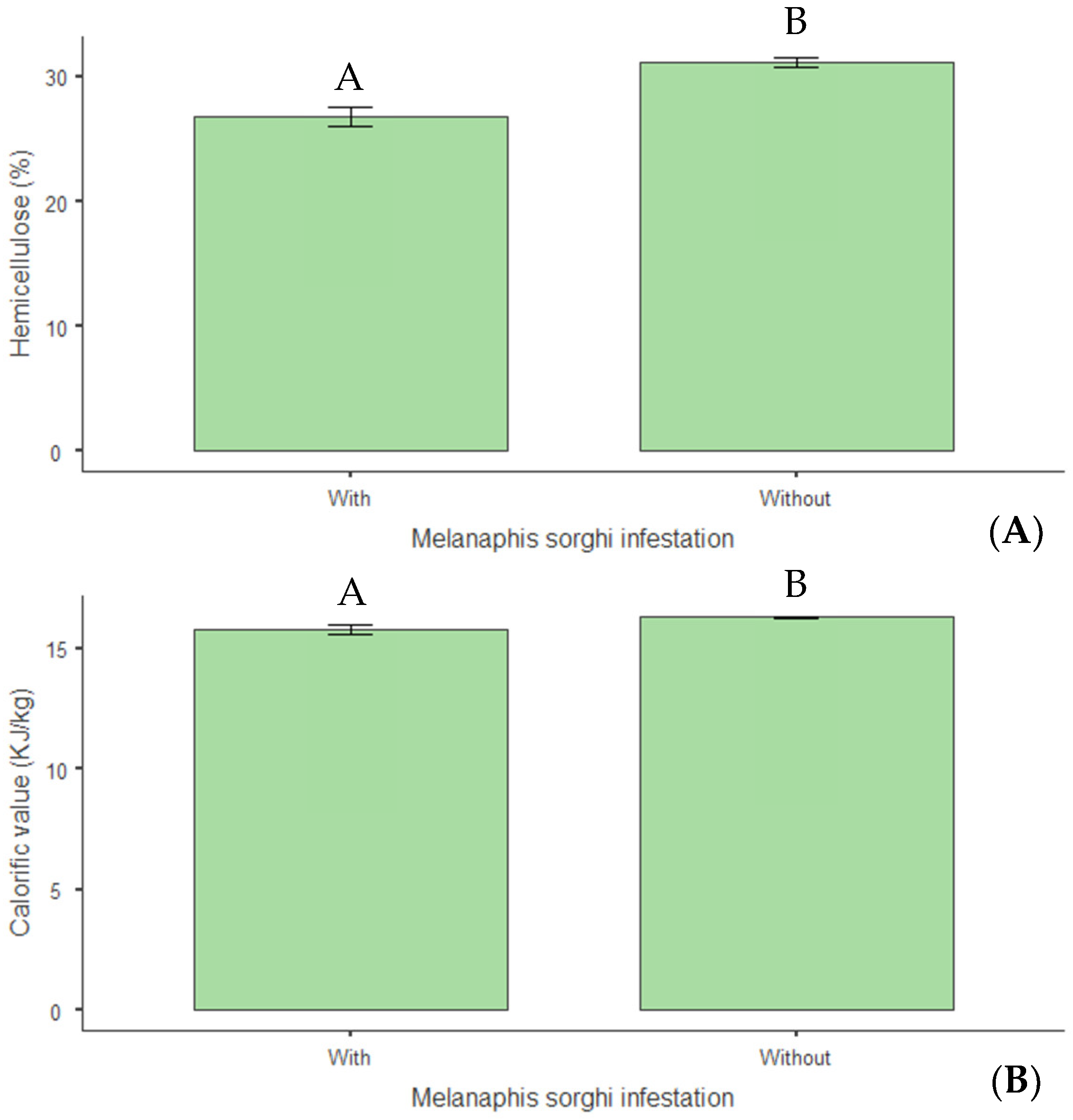

| Infestation Level | Aphid Density | Distribution | Symptoms |
|---|---|---|---|
| 20% | <10 aphids/leaf | Lower leaves and stem | No exuviae |
| 40% | <50 aphids/leaf | Lower leaves, stem, and middle leaves | Scattered exuviae |
| 60% | >50 aphids/leaf | Lower and middle leaves dominated | Abundant exuviae; initial yellowing/reddening |
| 80% | >200 aphids/leaf | Central veins and leaf margins affected | Evident symptoms; high exuviae density |
| 100% | Complete colonization | Entire plant | Leaf necrosis; generalized symptoms |
| Score | Symptoms | Visual Indicators |
|---|---|---|
| 1 | Few visible lesions | Minor discoloration |
| 2 | Initial reddish spots on the midrib; presence of exuviae | Localized damage and chlorosis |
| 3 | Scattered reddish spots; leaf margin yellowing; moderate exuviae | Chlorosis; exuviae accumulation and reddish spots |
| 4 | Reddish-yellowish spots; bronzed appearance; abundant exuviae | Advanced discoloration; exuviae density and honeydew accumulation |
| 5 | Reddish-yellow discoloration; initial leaf desiccation; reduced exuviae | Severe tissue damage; early necrosis and sooty mold fungus |
| 6 | Complete plant death | Total collapse of plant structure |
Disclaimer/Publisher’s Note: The statements, opinions and data contained in all publications are solely those of the individual author(s) and contributor(s) and not of MDPI and/or the editor(s). MDPI and/or the editor(s) disclaim responsibility for any injury to people or property resulting from any ideas, methods, instructions or products referred to in the content. |
© 2025 by the authors. Licensee MDPI, Basel, Switzerland. This article is an open access article distributed under the terms and conditions of the Creative Commons Attribution (CC BY) license (https://creativecommons.org/licenses/by/4.0/).
Share and Cite
Santos, D.G.; Dias, L.L.C.; Avellar, G.S.; Simeone, M.L.F.; Parrella, R.A.C.; Santos, N.M.; Silva, T.F.; Neto, A.A.; Mendes, S.M. Biomass Sorghum (Sorghum bicolor) Agronomic Response to Melanaphis sorghi (Hemiptera: Aphididae) Infestation and Silicon Application. Insects 2025, 16, 566. https://doi.org/10.3390/insects16060566
Santos DG, Dias LLC, Avellar GS, Simeone MLF, Parrella RAC, Santos NM, Silva TF, Neto AA, Mendes SM. Biomass Sorghum (Sorghum bicolor) Agronomic Response to Melanaphis sorghi (Hemiptera: Aphididae) Infestation and Silicon Application. Insects. 2025; 16(6):566. https://doi.org/10.3390/insects16060566
Chicago/Turabian StyleSantos, Douglas G., Leonardo L. C. Dias, Guilherme S. Avellar, Maria Lúcia F. Simeone, Rafael A. C. Parrella, Nathan M. Santos, Thaís F. Silva, Antônio A. Neto, and Simone M. Mendes. 2025. "Biomass Sorghum (Sorghum bicolor) Agronomic Response to Melanaphis sorghi (Hemiptera: Aphididae) Infestation and Silicon Application" Insects 16, no. 6: 566. https://doi.org/10.3390/insects16060566
APA StyleSantos, D. G., Dias, L. L. C., Avellar, G. S., Simeone, M. L. F., Parrella, R. A. C., Santos, N. M., Silva, T. F., Neto, A. A., & Mendes, S. M. (2025). Biomass Sorghum (Sorghum bicolor) Agronomic Response to Melanaphis sorghi (Hemiptera: Aphididae) Infestation and Silicon Application. Insects, 16(6), 566. https://doi.org/10.3390/insects16060566







